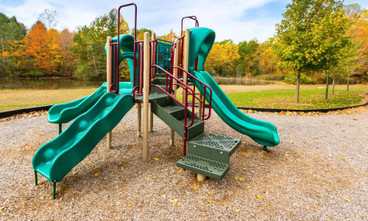Have you ever been to a playground without a border around it? The area tends to look unkempt or incomplete. If you are a commercial playground installer, are in charge of an area using commercial play center equipment, or want high-quality items for your residential play area, it’s important to understand the best playground border materials to use and why it’s important to place a border around the playground. Follow along as we discuss playground borders.
What Is a Playground Border?
A playground border, also called edging or a barrier, is any material placed all around the boundaries of the play equipment or play area. Barriers don’t move easily after installation; however, they are usually removable with some effort so when replacing is necessary, you can put in a new edge or repair the current one.
There are many advantages to using a border around a playground. Let’s look at what those are.
Safe
At a playground, you’ve likely laid mulch or some other padding around the area so children have a soft place on which to run or fall. A border helps contain the cushion you’ve chosen so it doesn’t spread out and begin to disappear. The layers of padding help play areas meet the maximum fall height requirements. As mulch or other forms of protection start to spread out away from the play area, that height is lost.
Cost Effective
Mulch or any surfacing material you use at a playground is a big investment. It isn’t wise to let it blow away or get pushed out because there is no border to help it stay in place. Use a barrier to keep your play area surface material in one spot and spend less money replacing it.
Nice and Neat
Would you rather bring your children to a playground that looks messy or one that is neat and tidy? Most of us would choose neat and tidy. First impressions are important, and when people walk to a play area and see that the equipment is clean and up-to-date and there is a stable border all around, keeping the padded surface in place, it gives them a sense of security knowing that whoever is running it, cares about the children’s safety and enjoyment.
Better for the Grounds Crew
When the cleanup crew comes around to clean the equipment, it’s a waste of their time to pull all the mulch back into the play area. Save them time by keeping a border around the surface. Also, the landscaping crew will have an easier time mowing and edging the surrounding grass when they don’t have to fight surface material scattered into it.
Gives Children Boundaries
It’s so helpful for caregivers when they don’t have to keep reminding children of where the play area starts and ends. A simple border gives kids an immediate mental note of where the play area is and where they need to stay.
Different Border Materials
There are four common types of border materials, including plastic, rubber, wood, and wood composite. Let’s look at each one and see the differences.
Plastic Borders
Plastic is a popular choice to replace other materials that aren’t as easy to maintain. Here are some benefits of plastic borders for your playground:
- Easy to clean and maintain since plastic won’t rust
- Clickable systems that allow you to simply click the plastic border pieces together
- Lightweight for easy installation and removal
- Colorful options for a fun playground aesthetic
- No metal or wood that can scratch or cause splinters
- Easy to create different shapes
All in all, plastic borders are some of the easiest to work with and maintain.
Wood Borders
Wood borders offer a classic, traditional look to a playground. You may see them more often at older, more established play areas. Wood has its pros and cons, which include the following:
- Looks classic and natural
- Cuts easily to fit but requires exact measurements and cutting skills
- Should be treated and varnished
- Untreated wood prone to splintering
- Hard surface area may cause injuries
Wood borders are best for play areas with wooden equipment or parks, as it completes an all-natural aesthetic.
Composite Wood Borders
Composite wood is a combination of plastic and wood and is a great option to take the place of real wood. Below are some benefits of composite wood borders.
- Durable and outlasts wood
- Easy to install and lightweight
- No splinters
Real wooden borders are usually made from railroad ties, but composite wood has more options and a lower profile that still presents a natural wood-look style.
Rubber Borders
Rubber, like plastic, offers more options for playground borders. Let’s look at the benefits of rubber borders.
- Lightweight and easy to install
- Bends easily and can be twisted into any shape you choose
- Softer surface cushions falls
- No scratching or splintering
- Can handle all kinds of weather and needs little upkeep
Another great benefit of rubber borders is that you can get creative with the type of rubber you use. Old tires make a fun border, and children have fun running through them like an obstacle course.
As you search for the best material for a playground border, keep in mind these four thoughts:
- The climate in which you live: harsh winters and salty air are tough on wood borders.
- The average age of the children playing in the area: little ones fall often and need a border that’s forgiving.
- Your budget: compare costs and choose a material that is affordable.
- The playground’s design: match materials or coordinate the border with the overall style of the playground.
There isn’t one material that is best for every setting; however, plastic and rubber make affordable choices that are highly durable and safe in all kinds of situations.
At Discount Playground Supply, we offer high-quality playground barriers in plastic and rubber options. We believe these materials are the best choices for any type of commercial or residential play area. Contact us today, and let’s make your playground border vision a reality.


